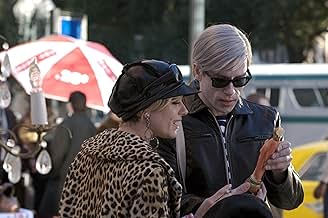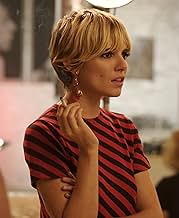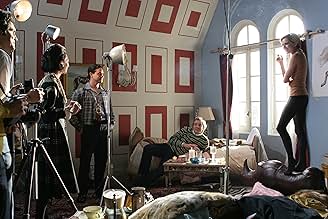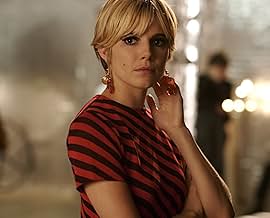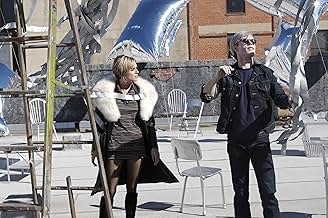Basado en el ascenso y caída de la socialité Edie Sedgwick, concentrándose en sus relaciones con Andy Warhol y una cantante de folk.Basado en el ascenso y caída de la socialité Edie Sedgwick, concentrándose en sus relaciones con Andy Warhol y una cantante de folk.Basado en el ascenso y caída de la socialité Edie Sedgwick, concentrándose en sus relaciones con Andy Warhol y una cantante de folk.
- Dirección
- Guionistas
- Elenco
- Premios
- 1 nominación en total
Opiniones destacadas
Just in case you read some of the rather hysterical comments and garner the impression that it's supposed to be about real people, it's not. Andy Warhol was never a real person, just a performance.
Guy Pearce presents Andy Warhol as the superficial creature he undoubtedly was. The original art-as-business creator, the very God at whose altar such modern day charlatans as Damien Hirst worship. Pearce's performance is riveting, his Andy Warhol is as empty as his crapulous art; just a two-dimensional diagram of someone who leaves no shadow. A cartoon.
Sienna Miller's performance as Edie Sedgewick is the best thing she's ever done. Caught in the strobe lights of Warhol's strangely sterile world of non-sexual sex and sofas still in their plastic wrappers, Edie becomes the focus of his short attention span for a while. She flashes across the screen like a speeded up Holly Golighty, while Warhol's voyeuristic viewfinder traps her in it's leering stare. The camera loves her and so does Warhol. But we know it's going to end in tears.
Nothing in the movie has much depth, none of the characters are developed beyond what we already know about them and the whole sixties New York scene is represented by a series of iconic "things". The Chelsea Hotel, the Velvet Underground, a soundtrack of songs that sound right but which actually don't fit at all. For instance, "Leavin' here" by The Birds, a British group in which Ronnie Wood was the guitarist, was recorded in 1966 but was never released in America. However, there it is on the soundtrack being played in the factory sometime in 1965.
But no matter.
The movie pretty much captures the shallow, transient and utterly facile world of Warhol in the sixties and in another way it sums up the emptiness and tragedy of the Hollywood dream machine too. But it doesn't ask any deep questions nor does it pretend to be something it's not. It's entertaining and worth watching for two very good performances by Guy Pearce and Sienna Miller.
It's not art, it's just a movie, albeit a superficial one.
Okay, let me say that I enjoyed Factory Girl for what it is and think it is worth renting.
The story stars Sienna Miller as the fated Edie Sedgwick and Guy Pearace as vapid pop culture icon, Andy Warhol.
The movie isn't nearly as close to as bad as critics claim it is. The first 40 minutes is much ado about talk of cocks, Andy and Edie's irreverence, and a series of disjointed images. The first act is aimless. But it makes sense because Edie and Andy are aimless and so are the termites chewing Andy's wood at "The Factory".
Enter Hayden Christensen as Billy Quinn and the movie develops its paper thin plot. Though, I should say it's unfair to characterize the story this way. Edie's life was a paper thin plot, so the director, Hickenlooper can't be blamed for that.
Andy, who never says he is gay, though everyone else assumes (or knows) he is, is in love with the idea of Edie "The Superstar" and Billy Quinn simply wants to open her eyes. She becomes the rope in a tug of war. Billy's "soul" cries for the world in a time of upheaval versus the-devil-may-care, drug den world of Andy. And while the latter may be in "love" with his muse, Billy cares and wants Edie to know, if art is the food of the soul, then Edie is eating from an empty soup can.
Edie is a sympathetic character. You get the sense that no one really knew her. Not because she was empty and vapid but that she was so shattered inside the only part of herself she allowed the world to see was the facade her Andy created. In Factory Girl we see Edie through the looking glass. Not as she was, but as she appeared. Warped.
Edie is the cute girl you meet in passing at a party at some stranger's house. You like her, but never see her again. Though, over the years you hear the occasional rumor or two, until one day, you hear she's hit rock bottom and died. That's how it feels to watch Edie Sedgewick's story in The Factory Girl. On one hand, you want to mourn her. On the other hand, you wonder, what has the world lost? That in itself is the real tragedy.
With her big raccoon eyes, pre-punk hairdo and flashing smile, Miller bears such a striking resemblance to the real-life Sedgwick that she carries much of the film by the sheer will of her character's Holly Golightly-like sense of exalted self-worth. But like Holly, Sedgwick lacked talent to sustain a film career, and the script leaves Miller to her own devices in connecting us with her character's tormented psyche amid her escalating drug use. On the upside, Guy Pearce accurately captures the discomfiting public image of Warhol down to the familiar narcissistic indifference and manipulative shyness, but his character gradually recedes into the background. At first, Hayden Christensen comes across as amateurish and unintentionally amusing as a Bob Dylan doppelganger, especially since he makes a feeble attempt at capturing the singer's recognizable speech cadences. Just as he manages to transcend the awkwardness of the character's intrusion into the story, he also disappears making his impact in Sedgwick's life feel rather fleeting.
Even though the cryptic screenplay by Captain Mauzner, Aaron Richard Golub and Simon Monjack conveniently paints Warhol and the faux-Dylan as polarizing figures pulling at Sedgwick's soul, the story really comes down to her own inner demons. The problem is that she remains oddly elliptical throughout, and Hickenlooper seems satisfied with leaving us with an impressionistic view of a person who barely warrants our attention forty years later. Among the supporting players, there are quite a familiar faces - Ileana Douglas as Vogue editor Diana Vreeland, Jimmy Fallon as Sedgwick's confidante Chuck Wein, Tara Summers as fellow Warhol protégé Brigid Berlin, Mena Suvari as Brigid's sister Richie, Edward Herrmann as the family attorney, Mary Kate Olsen as a partygoer. However, none of them are given any opportunity to shine.
¿Sabías que…?
- TriviaSienna Miller improvised the scene in which Edie tells The Musician about her brothers' deaths.
- ErroresEdie Sedgwick's relationship to Nico is depicted incorrectly: in reality they were friends and Edie warned Nico about Andy Warhol's behavior. Edie's death was very sad for Nico.
- Citas
Andy Warhol: I wonder if people are going to remember us?
Edie Sedgwick: What, when we're dead?
Andy Warhol: Yeah.
Edie Sedgwick: Well, I think people will talk about how you changed the world.
Andy Warhol: I wonder what they'll say about you... in your obituary. I like that word.
Edie Sedgwick: Nothing nice, I don't think.
Andy Warhol: No no, come on. They'd say, "Edith Minturn Sedgwick: beautiful artist and actress...
Edie Sedgwick: ...and all-around loon.
Andy Warhol: ...Remembered for setting the world on fire...
Edie Sedgwick: ...and escaping the clutches of her terrifying family...
Andy Warhol: ...Made friends with eeeeverybody and anybody...
Edie Sedgwick: ...creating chaos and uproar wherever she went. Divorced as many times as she married, she leaves only good wishes behind.
[laughs]
Edie Sedgwick: That's nice, isn't it?
- Créditos curiososDuring the first part of the end credits, photos are shown of the real Edie Sedgwick. Also people who knew her give testimonies about her.
- Versiones alternativasAccording to the FAQ section: "For the home theatre market, an unrated version was released aside from the R-rated theatrical version. Most scenes which were re-inserted or alternately shifted, serve to specify character drawings and various aspects of the story which were only embedded in the theatrical version to some extent. However, there are also a few extensions with sexual contents and more explicit depictions of drug use."
- Bandas sonorasDino's Song
Written by Chet Powers (uncredited)
Performed by Quicksilver Messenger Service
Courtesy of Capitol Records
Under License from EMI Film & Television Music
Selecciones populares
Detalles
- Fecha de lanzamiento
- País de origen
- Idiomas
- También se conoce como
- Factory Girl
- Locaciones de filmación
- Productoras
- Ver más créditos de la compañía en IMDbPro
Taquilla
- Presupuesto
- USD 7,000,000 (estimado)
- Total en EE. UU. y Canadá
- USD 1,675,241
- Total a nivel mundial
- USD 3,572,632
- Tiempo de ejecución1 hora 40 minutos
- Color
- Mezcla de sonido
- Relación de aspecto
- 1.85 : 1
Contribuir a esta página




